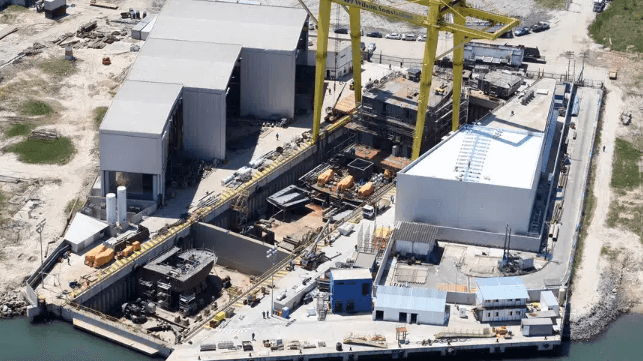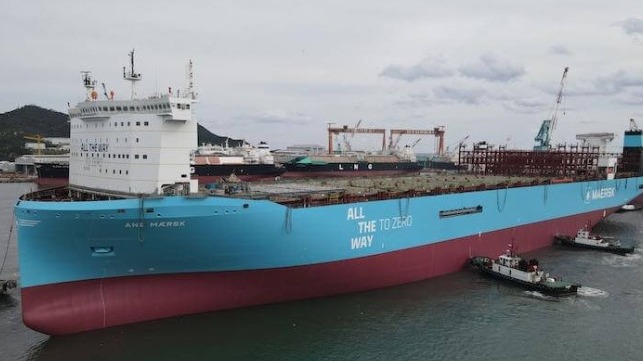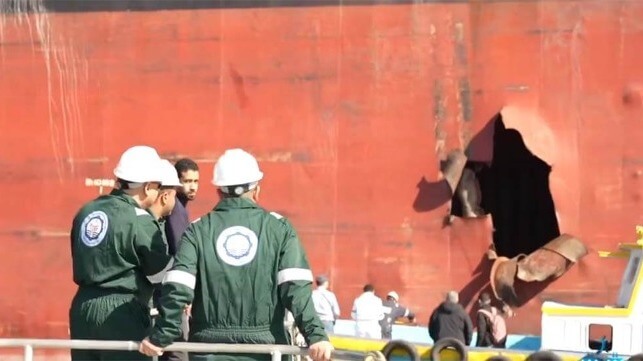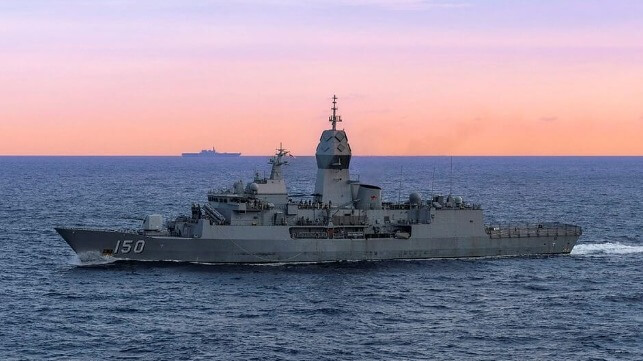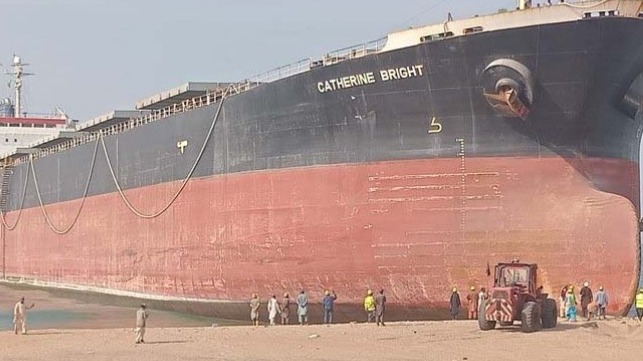Biden Must Choose between a Ceasefire in Gaza and a Regional War
Houthi-affiliated Yemeni coastguard patrols the Red Sea, flying Palestinian and Yemeni flags. [Credit: AFP]
In the topsy-turvy world of corporate media reporting on U.S. foreign policy, we have been led to believe that U.S. air strikes on Yemen, Iraq and Syria are legitimate and responsible efforts to contain the expanding war over Israel’s genocide in Gaza, while the actions of the Houthi government in Yemen, Hezbollah in Lebanon, and Iran and its allies in Iraq and Syria are all dangerous escalations.
In fact, it is U.S. and Israeli actions that are driving the expansion of the war, while Iran and others are genuinely trying to find effective ways to counter and end Israel’s genocide in Gaza while avoiding a full-scale regional war.
We are encouraged by Egypt and Qatar’s efforts to mediate a ceasefire and the release of hostages and prisoners-of-war by both sides. But it is important to recognize who are the aggressors, who are the victims, and how regional actors are taking incremental but increasingly forceful action to respond to genocide.
A near-total Israeli communications blackout in Gaza has reduced the flow of images of the ongoing massacre on our TVs and computer screens, but the slaughter has not abated. Israel is bombing and attacking Khan Younis, the largest city in the southern Gaza Strip, as ruthlessly as it did Gaza City in the north. Israeli forces and U.S. weapons have killed an average of 240 Gazans per day for more than three months, and 70% of the dead are still women and children.
Israel has repeatedly claimed it is taking new steps to protect civilians, but that is only a public relations exercise. The Israeli government is still using 2,000 pound and even 5,000 pound “bunker-buster” bombs to dehouse the people of Gaza and herd them toward the Egyptian border, while it debates how to push the survivors over the border into exile, which it euphemistically refers to as “voluntary emigration.”
People throughout the Middle East are horrified by Israel’s slaughter and plans for the ethnic cleansing of Gaza, but most of their governments will only condemn Israel verbally. The Houthi government in Yemen is different. Unable to directly send forces to fight for Gaza, they began enforcing a blockade of the Red Sea against Israeli-owned ships and other ships carrying goods to or from Israel. Since mid-November 2023, the Houthis have conducted about 30 attacks on international vessels transiting the Red Sea and Gulf of Aden but none of the attacks have caused casualties or sunk any ships.
In response, the Biden administration, without Congressional approval, has launched at least six rounds of bombing, including airstrikes on Sanaa, the capital of Yemen. The United Kingdom has contributed a few warplanes, while Australia, Canada, Holland and Bahrain also act as cheerleaders to provide the U.S. with the cover of leading an “international coalition.”
President Biden has admitted that U.S. bombing will not force Yemen to lift its blockade, but he insists that the U.S. will keep attacking it anyway. Saudi Arabia dropped 70,000 mostly American (and some British) bombs on Yemen in a 7-year war, but utterly failed to defeat the Houthi government and armed forces.
Yemenis naturally identify with the plight of the Palestinians in Gaza, and a million Yemenis took to the street to support their country’s position challenging Israel and the United States. Yemen is no Iranian puppet, but as with Hamas, Hezbollah, and Iran’s Iraqi and Syrian allies, Iran has trained the Yemenis to build and deploy increasingly powerful anti-ship, cruise and ballistic missiles.
The Houthis have made it clear that they will stop the attacks once Israel stops its slaughter in Gaza. It beggars belief that instead of pressing for a ceasefire in Gaza, Biden and his clueless advisers are instead choosing to deepen U.S. military involvement in a regional Middle East conflict.
The United States and Israel have now conducted airstrikes on the capitals of four neighboring countries: Lebanon, Iraq, Syria and Yemen. Iran also suspects U.S. and Israeli spy agencies of a role in two bomb explosions in Kerman in Iran, which killed about 90 people and wounded hundreds more at a commemoration of the fourth anniversary of the U.S. assassination of Iranian General Qasem Soleimani in January 2020.
On January 20, an Israeli bombing killed 10 people in Damascus, including 5 Iranian officials. After repeated Israeli airstrikes on Syria, Russia has now deployed warplanes to patrol the border to deter Israeli attacks, and has reoccupied two previously vacated outposts built to monitor violations of the demilitarized zone between Syria and the Israeli-occupied Golan Heights.
Iran has responded to the terrorist bombings in Kerman and Israeli assassinations of Iranian officials with missile strikes on targets in Iraq, Syria and Pakistan. Iranian Foreign Minister Amir-Abdohallian has strongly defended Iran’s claim that the strikes on Erbil in Iraqi Kurdistan targeted agents of Israel’s Mossad spy agency.
Eleven Iranian ballistic missiles destroyed an Iraqi Kurdish intelligence facility and the home of a senior intelligence officer, and also killed a wealthy real estate developer and businessman, Peshraw Dizayee, who had been accused of working for the Mossad, as well as of smuggling Iraqi oil from Kurdistan to Israel via Turkey.
The targets of Iran’s missile strikes in northwest Syria were the headquarters of two separate ISIS-linked groups in Idlib province. The strikes precisely hit both buildings and demolished them, at a range of 800 miles, using Iran’s newest ballistic missiles called Kheybar Shakan or Castle Blasters, a name that equates today’s U.S. bases in the Middle East with the 12th and 13th century European crusader castles whose ruins still dot the landscape.
Iran launched its missiles, not from north-west Iran, which would have been closer to Idlib, but from Khuzestan province in south-west Iran, which is closer to Tel Aviv than to Idlib. So these missile strikes were clearly intended as a warning to Israel and the United States that Iran can conduct precise attacks on Israel and U.S. “crusader castles” in the Middle East if they continue their aggression against Palestine, Iran and their allies.
At the same time, the U.S. has escalated its tit-for-tat airstrikes against Iranian-backed Iraqi militias. The Iraqi government has consistently protested U.S. airstrikes against the militias as violations of Iraqi sovereignty. Prime Minister Sudani’s military spokesman called the latest U.S. airstrikes “acts of aggression,” and said, “This unacceptable act undermines years of cooperation… at a time when the region is already grappling with the danger of expanding conflict, the repercussions of the aggression on Gaza.”
After its fiascos in Afghanistan and Iraq killed thousands of U.S. troops, the United States has avoided large numbers of U.S. military casualties for ten years. The last time the U.S. lost more than a hundred troops killed in action in a year was in 2013, when 128 Americans were killed in Afghanistan.
Since then, the United States has relied on bombing and proxy forces to fight its wars. The only lesson U.S. leaders seem to have learned from their lost wars is to avoid putting U.S. “boots on the ground.” The U.S. dropped over 120,000 bombs and missiles on Iraq and Syria in its war on ISIS, while Iraqis, Syrians and Kurds did all the hard fighting on the ground.
In Ukraine, the U.S. and its allies found a willing proxy to fight Russia. But after two years of war, Ukrainian casualties have become unsustainable and new recruits are hard to find. The Ukrainian parliament has rejected a bill to authorize forced conscription, and no amount of U.S. weapons can persuade more Ukrainians to sacrifice their lives for a Ukrainian nationalism that treats large numbers of them, especially Russian speakers, as second class citizens.
Now, in Gaza, Yemen and Iraq, the United States has waded into what it hoped would be another “US-casualty-free” war. Instead, the U.S.-Israeli genocide in Gaza is unleashing a crisis that is spinning out of control across the region and may soon directly involve U.S. troops in combat. This will shatter the illusion of peace Americans have lived in for the last ten years of U.S. bombing and proxy wars, and bring the reality of U.S. militarism and warmaking home with a vengeance.
Biden can continue to give Israel carte-blanche to wipe out the people of Gaza, and watch as the region becomes further engulfed in flames, or he can listen to his own campaign staff, who warn that it’s a “moral and electoral imperative” to insist on a ceasefire. The choice could not be more stark.
Medea Benjamin and Nicolas J. S. Davies are the authors of War in Ukraine: Making Sense of a Senseless Conflict, published by OR Books, November 2022. Medea Benjamin is the cofounder of CODEPINK for PEACE, and the author of several books, including Inside Iran: The Real History and Politics of the Islamic Republic of Iran. Nicolas J. S. Davies is an independent journalist, a researcher for CODEPINK and the author of Blood on our Hands: The American Invasion and Destruction of Iraq.
Toward the Abyss
United States’ fatal relationship with Israel
One word characterizes United States foreign policy – counterproductive.
Major U.S. foreign policy decisions after World War II — Vietnam War, Lebanon intrusion, Somalia incursion, Afghan/Soviet War, Afghan occupation, Iraq War, support for Shah of Iran, and Libyan Wars — have been counterproductive, not resolving situations and eventually harming the American people. The one-sided relationship the United States has with Israel is another counterproductive policy that is harmful to the American public
Persistent attention to Israel and its dubious position in the world may seem overkill, except this attention is one of the most important, mortally affecting the U.S. public. Until a complete report of fatal relations with Israel is placed on the desks of U.S. congresspersons and they act positively upon the contents, attention to the issue is incomplete and peril continues. Surveying U.S. policies that favored Israel collects a horrendous list of American fatalities, economic havoc, international terrorism, political misalignment, hatred, and aggression against fortress America.
Two questions. How have the expensive arrangements, Velcro attachments, and highly supportive measures for Israel benefitted the United States? What has Israel done for Americans, not for American politicians, but for those who vote them into office? A convenient means for obtaining the answer is to have a leading “think tank” in the United States supply the information. The Washington Institute for Near East Policy, which “seeks to advance a balanced and realistic understanding of American interests in the Middle East and to promote the policies that secure them” has a 2012 article on the topic, “Friends with Benefits: Why the U.S.-Israeli Alliance Is Good for America,” by Michael Eisenstadt and David Pollock, Nov 7, 2012, and is a likely source. Some of its major recommendations:
U.S.-Israeli security cooperation dates back to heights of the Cold War, when the Jewish state came to be seen in Washington as a bulwark against Soviet influence in the Middle East and a counter to Arab nationalism….Israel remains a counterweight against radical forces in the Middle East, including political Islam and violent extremism. It has prevented the proliferation of weapons of mass destruction in the region by thwarting Iraq and Syria’s nuclear programs.
(1) The reason the Soviet Union acquired influence in the Middle East was Washington’s refusal to sell arms to the Arab nations, while “indirectly supplying weapons to Israel via West Germany, under the terms of a 1960 secret agreement to supply Israel with $80 million worth of armaments.“ Less secret deliveries of MIM-23 Hawk anti-aircraft missiles in 1962 and M48 Patton tanks in 1965 told the Arab nations they could not collaborate with a government that armed their principal adversary and they should seek military assistance elsewhere.
(2) Arab nationalism has developed, and developed, and developed; so, how did Israel counter Arab nationalism? Did Israel stimulate Arab nationalism?
(3) What has Israel done to protect others as a “counterweight against radical forces in the Middle East, including political Islam and violent extremism?” The answer is nothing. Radical forces, political Islam, and violent extremism emerged immediately after Israel’s formation and grew, and grew, as Israel grew.
(4) Iraq and Syria sought nuclear weapons to counter Israel’s nuclear weapons developments, which the U.S. could have and should have prevented. No nukes in Israel; no nukes in Syria or Iraq. Why did the U.S., dedicated to preventing nuclear proliferation, allow Israel to obtain the atomic bomb?
Dozens of leading U.S. companies have set up technology incubators in Israel to take advantage of the country’s penchant for new ideas. In 2011, Israel was the destination of 25 percent of all U.S. exports to the region, having recently eclipsed Saudi Arabia as the top market there for American products.
(1) U.S. companies have subsidiaries worldwide and hire talent in all nations. What’s significant about Israel?
(2) “In 2011, Israel was the destination of 25 percent of all U.S. exports to the region…” Was that good? In 2022, U.S. exports to Israel were $20.0 billion and imports were $30.6 billion, adding $10.7 billion to Washington’s trade deficit, not a good economic statistic. Without Israel’s trade, the U.S. exported $83 billion in goods and services to Middle East nations and had a trade surplus of $5.3 billion, a better statistic.
U.S. companies’ substantial cooperation with Israel on information technology has been crucial to Silicon Valley’s success. At Intel’s research and development centers in Israel, engineers have designed many of the company’s most successful microprocessors, accounting for some 40 percent of the firm’s revenues last year. If you’ve made a secure financial transaction on the Internet, sent an instant message, or bought something using PayPal, you can thank Israeli researchers.
These bites of public relations win the all-time Pinocchio award. Is The Washington Institute a legitimate “think tank” or a covert lobby?
(1) “Israel has been crucial to Silicon Valley’s success.” Next, we’ll hear that Moses received the Ten Commandments on Mt. Whitney.
(2) “At Intel’s research and development centers in Israel, engineers have designed many of the company’s most successful microprocessors, accounting for some 40 percent of the firm’s revenues last year.” Intel has 131,000 employees in 65 countries — 11,000 in Israel, 12,000 in China, and approximately 7,500 employees at its 360-acre Leixlip campus in Ireland. The company develops the processors, not the country or specific engineers; it can develop the same processors anywhere in the world and has capably developed its major microprocessors for 45 years in the good old United States of America.
(3) “If you’ve made a secure financial transaction on the Internet, sent an instant message, or bought something using PayPal, you can thank Israeli researchers.” Another Pinocchio award. Let’s be more accurate: “If you’ve been scammed in a financial transaction, had your messages hacked, or had someone purchase an item with your PayPal account, thank Israeli researchers.”
In its one-sided presentation, The Washington Institute for Near East Policy does not show the U.S.-Israeli alliance is good for America. The Institute has not considered the other side, the harm that Israel has visited upon its most essential partner. Reality shows the U.S. government and its people have dealt with Israel in a suicidal manner and in a zero-sum game, where the U.S. is the “zero,” or actually minus, and Israel receives the sum of all the benefits.
Recognition of Israel
From its inception, Israel betrayed the United States and the U.S. betrayed its commitment to a just and peaceful post-WWII world. President Harry S. Truman’s recognition of the new state, only 11 minutes after its declaration, did not consider its composition, signified a pardon of the excesses committed by Irgun and Haganah militias against civilian populations, and certified the exclusion of a Palestinian voice in the new government. Truman never asked who represented the 400,000 indigenous Palestinians in the declared Israeli state that was almost equal in population to the 600,000 Jews, most of whom were recent immigrants and not decidedly permanent.
Suez Canal War
Several years later Israel again betrayed its principal benefactor. While President Eisenhower attempted to broker a peace agreement between Egypt and France and Great Britain that would resolve the crisis emerging from Egyptian President Gamal Abdel Nasser’s nationalization of the Suez Canal, Israel held secret consultations with the British and French. Considering Nasser a threat to its security, desirous of incorporating the Sinai into its small nation, and with a plan to extend Israel to the Litani River in Lebanon, Israel devised a strategy with the two European powers that permitted its forces to invade Egypt and advance to within 10 miles of the Suez Canal. Pretending to protect the vital artery, Britain and France parachuted troops close to the canal. An enraged Eisenhower threatened all three nations with economic sanctions, which succeeded in having all three militaries withdraw their forces and relinquish control of the canal to Egypt.
Six-Day War
The six-day war brought the first American blood in the U.S. commitment to Israel. On June 8, 1967, Israeli warplanes and torpedo boats attacked the USS Liberty, an intelligence-gathering vessel patrolling in the Eastern Mediterranean Sea, 17 nautical miles off the northern Sinai coast. The crew suffered thirty-four (34) killed and one hundred seventy-three (173) wounded. A declassified Top Secret report details the CIA version of the attack and exonerates Israel by claiming mistaken identity. This has not satisfied USS Liberty survivors, who felt Israeli pilots had many opportunities for proper identification and performed the attacks to prevent the ship from obtaining important intelligence information.
1973 Yom Kippur War
Next came the 1973 Yom Kippur War and an economic catastrophe for the American people. The U.S. maintained it needed Israel to offset Soviet influence in the Arab world. The combined Egyptian and Syrian attempt to retake lands lost in the 1967 war prompted the Nixon administration to use taxpayer money and supply massive shipments of weapons to the beleaguered Israel state. An excuse for providing the armaments shipments ─ Israel might use the Samson option and nuke its adversaries ─ is regarded as a manipulation to pacify opponents of the arms deliveries. The controversy is reported in Wikipedia.
Dayan raised the nuclear topic in a cabinet meeting, warning that the country was approaching a point of “last resort.” That night, Meir authorized the assembly of thirteen 20-kiloton-of-TNT(84 TJ) tactical nuclear weapons for Jericho missiles at Sdot Micha Airbase and F-4 Phantom II aircraft at Tel Nof Airbase. They would be used if absolutely necessary to prevent total defeat, but the preparation was done in an easily detectable way, likely as a signal to the United States. Kissinger learned of the nuclear alert on the morning of 9 October. That day, President Nixon ordered the commencement of Operation Nickel Grass, an American airlift to replace all of Israel’s material losses.
The U.S. contribution in enabling Israel to achieve a decisive victory resulted in an oil embargo that drove up oil prices, set Americans into a frantic rampage in trying to keep their cars on the road, a stagnant economy, and huge inflation, which the Federal Reserve stopped by raising interest rates to record highs and led to the 1982 recession.
Lebanon War
Despite a truce with the Palestine Liberation Organization (PLO) and wanting to rid Lebanon of the PLO and Syrian dominance in Lebanon affairs, Israel used a failed assassination of Shlomo Argov, Israel’s ambassador to the United Kingdom, as an excuse to invade Lebanon on June 6, 1982. Where Israel went, U.S. diplomacy was sure to follow, and the U.S. joined a multinational peacekeeping force.
U.S. presence in Lebanon had detractors. On April 18, 1983, a car bomb destroyed the U.S. embassy in West Beirut, killing dozens of American foreign service workers and Lebanese civilians. On October 23, 1983, after U.S. gunships in the Mediterranean shelled Syrian-backed Druze militias in support of the Christian government, a truck crashed through the front gates of the U.S. Marine barracks in Beirut and exploded. Beirut barracks were destroyed and 241 marines and sailors were killed in the explosion. Soon after, President Reagan withdrew all U.S. forces from Lebanon.
International Terrorism
For several decades, al-Qaeda, the most prominent international terrorist organization, posed the most serious threat to America’s peace and stability. On August 7, 1998, al-Qaeda associates bombed the American embassies in Nairobi, Kenya, and Dar es Salaam, Tanzania, in Africa. Twelve Americans were among the two hundred and twenty-four people who died in the terrorist actions. Three years later, the September 11 attacks in New York City and Washington, D.C. caused 2,750 deaths in New York and 184 at the Pentagon. Forty more Americans died when one of the hijacked planes crashed into the ground in Pennsylvania. In addition, 400 police officers and firefighters perished in attempts to rescue people and extinguish the fires at the New York Trade Center.
Where did it all start? Why, and how did master terrorist Osama bin Laden develop his plans? There is no one factor, but, in several documents, bin Landen mentions Zionist control of Middle East lands and its oppression of an Arab population as significant factors. America’s support for Israel was one of bin Laden‘s principal arguments with the United States. The al-Qaeda leader revealed his attitude in the last sentences of a “Letter to America.”
Justice is the strongest army, and security is the best way of life, but it slipped out of your grasp the day you made the Jews victorious in occupying our land and killing our brothers in Palestine. The path to security is for you to lift your oppression from us.
During the 1990s, two other documents,“Declaration of War against the Americans Occupying the Land of the Two Holy Places” and the “Declaration of the World Islamic Front,” retrieved from Osama bin Laden, jihad, and the sources of international terrorism, J. M. B. Porter, Indiana International & Comparative Law Review, provide additional information on bin-Laden’s attachment of his terrorist responses to Zionist activities.
[T]he people of Islam have suffered from aggression, iniquity, and injustice imposed on them by the Zionist/Crusader alliance … Their blood was spilled in Palestine and Iraq. The horrifying pictures of the massacre of Qana, in Lebanon, are still fresh in our memory.
So now they come to annihilate … this people and to humiliate their Muslim neighbors. … if the Americans’ aims behind these wars are religious and economic, the aim is also to serve the Jews’ petty state and divert attention from its occupation of Jerusalem and murder of Muslims there. The best proof of this is their eagerness to destroy Iraq, the strongest neighboring Arab state, and their endeavor to fragment all the states of the region such as Iraq, Saudi Arabia, Egypt, and Sudan into paper statelets and through their disunion and weakness to guarantee Israel’s survival and the continuation of the brutal crusade occupation of the Peninsula.
Afghanistan
The hunt for Osama bin Laden and efforts to annihilate the al-Qaeda organization led to the invasion of Afghanistan and a twenty-year clash between the U.S. and the Taliban. Result: 2,402 United States military deaths, 20,713 American service members wounded, and Taliban regaining control.
Iraq
It’s difficult and punishing to agree with Osama bin Laden, but he may be correct or have a perspective that needs more examination. Did Bush order the invasion of Iraq to destroy Saddam Hussein’s weapons of mass destruction, which any child could ascertain he could not possibly have, or did the Neocons, Israel’s voice in the administration, convince him to use Americans, their resources, and their money to rid the Middle East of Israel’s most formidable enemy? Was George W. Bush’s uncalled-for war against Saddam Hussein in Iraq another example of sacrificing U.S. lives to advance Israel’s interests? Other international terrorist operations emerged during the Iraq war and brought U.S. military personnel into more battles. Finally, in 2019, the Islamic State of Iraq and Syria (ISIS), the best-equipped and largest of all the terrorist factions, which caused havoc in Syria and Iraq, was defeated, and international terrorism moved out of the Middle East and into parts of Africa.
Iran
It is taken for granted that Iran and the United States are natural enemies, except the hostility may be manufactured and the factory might be in Tel Aviv. Iran has a government and internal problems that disturb the U.S., but so do many other nations, especially Saudi Arabia, and the U.S. maintains relations with these nations. Confrontations have occurred and are escalating and that demands toning down rather than ratcheting up, and more diplomatic confrontations to prevent the physical confrontations. Sanctions that harm Iran’s economy and people, assistance to Israel in assassinating Iranian scientists, and use of the powerful computer worm, Stuxnet, to cause mayhem in Iran’s nuclear program are counterproductive provocations. The U.S. has no specific problem with Iran that cannot be ameliorated. Israel’s oppression of the Palestinians and incursions into the Haram al-Sharif are problems that Iran has with Israel, and they cannot be ameliorated until the oppression stops. Cunningly, Israel has tied its problems with the Islamic State to U.S. problems with Iran and uses the U.S. to challenge Iran.
Other
· In defiance of U.S. restrictions and the U.S. supplying Israel with advanced military equipment, Israeli companies sold weapons to China without a permit.
· The U.S. gives Israel the sum of $3.1 B every year to purchase advanced weapons, from which Israel became a major exporter of military equipment and has been able to compete effectively with its patron.
· Israeli governments have scoffed at all U.S. entreaties to halt settlement expansion, even insulting then Vice-President Joe Biden by authorizing settlement expansion one day before Biden arrived for talks.
· Two Navy SEALs are missing and assumed dead after a maritime operation to intercept weapons from Iran heading to Houthi fighters. This episode is a result of the U.S. participating in Israel’s war against Gaza.
· The Islamic Resistance in Iraq has been attacking air bases housing U.S. and Iraqi troops in western Iraq “as a part of a broad resistance to the presence of U.S. troops in Iraq, as well as a response to Israel’s operations in Gaza.”
Toward the Abyss
The verdict is clear; the United States derives no benefit from its close relationship with Israel. Maybe, during the confusing Cold War, desk strategists determined the Soviets had an influence with Middle Eastern nations and thought it wise to have a place where the Pentagon would be welcome. Soviet influence disappeared after the 1979 Camp David Accords; Egypt and Israel signed a peace agreement and Soviet diplomats and military vanished from the desert sands.
From September 11, 2001, to October 7, 2023, the U.S. continually suffered fatalities, economic havoc, international terrorism, political misalignment, hatred, and aggression against Fortress America. Why did U.S. administrations pursue a “special relationship” with Israel and find themselves victims of the “war on terror” and involved in numerous wars? The current U.S. administration, which did not use its clout to prevent the October 7, 2023 attack in Israel, has permitted Israel’s self-inflicted problems to bring the U.S. people into supporting the genocide of the Palestinian people, promoting the U.S. as the leading killer of indigenous peoples.
It took a long time to turn the murmurs of genocide in Palestine into a forceful expression that others would accept and fearlessly repeat. Murmurs of sabotage and treason by elected government officials are being heard, but they are legal terms for crimes, and, legally, U.S. legislators’ activities may not be considered in those categories. Treachery is a better word, gaining federal office by treacherous means — pandering to those that represent the interests of a foreign power to obtain campaign funds and press coverage — and using that office to satisfy the wants of the foreign power, despite the damage done to American constituencies. Past and present U.S. executives and legislators are guilty of treachery and that word should be shouted in the halls of Congress. Sound the alarm, get them out before it is too late, and elect into office those who represent the American people and not a foreign government. MAGA – MAKE AMERICA GOOD AGAIN.
Aiding the genocide has put the U.S. in severe moral decline; escalating internal divisions are leading to social and political decline; and an economy that can no longer compete in the international markets, together with increasing resistance to use of the dollar, is leading to economic decline. The signs of civil strife have yet to appear and when they do they will push the U.S. off the edge of the cliff and into the abyss.
Dan Lieberman publishes commentaries on foreign policy, economics, and politics at substack.com. He is author of the non-fiction books A Third Party Can Succeed in America, Not until They Were Gone, Think Tanks of DC, The Artistry of a Dog, and a novel: The Victory (under a pen name, David L. McWellan). Read other articles by Dan.

